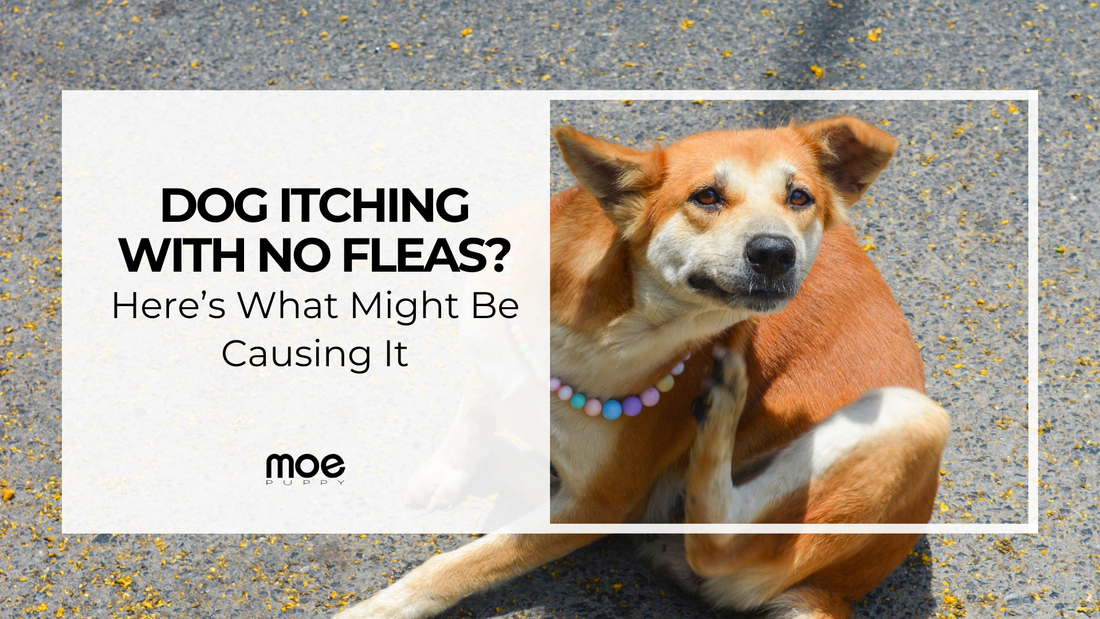
Dog Itching with No Fleas? Here’s What Might Be Causing It
Share
Dogs scratch themselves occasionally, but what if your furry friend is constantly itching with no fleas in sight? Persistent scratching can be frustrating for both you and your dog, but fleas aren’t always the culprit. If your dog is suffering from relentless itching, there might be an underlying cause that needs your attention.
Let’s explore the possible reasons behind dog itching and scratching without fleas and how you can help relieve their discomfort.
Common Causes of Dog Itching Without Fleas
1. Allergies
Allergies are one of the leading causes of itching in dogs. Just like humans, dogs can have allergic reactions to various things in their environment.
a. Food Allergies
Certain ingredients in your dog’s food, such as beef, chicken, dairy, or grains, can trigger allergic reactions. Symptoms may include:
- Chronic itching
- Red, inflamed skin
- Ear infections
- Digestive issues (vomiting, diarrhea)

b. Environmental Allergies (Atopy)
Dogs can be allergic to pollen, dust mites, mold, or grass. Signs of environmental allergies include:
- Seasonal itching (worse during certain times of the year)
- Scratching, licking, and chewing paws
- Red or watery eyes
c. Contact Allergies
Some dogs react to specific shampoos, cleaning products, or synthetic fabrics. If the itching is localized to areas that come into contact with a certain material, it could be a contact allergy.
To help soothe allergic reactions caused by environmental irritants, using a high-quality shampoo designed for dogs can be beneficial. The Xtra Nourish with Dead Sea Salt Dog Shampoo is enriched with Dead Sea minerals that can help calm irritated skin, moisturize dryness, and promote healing. Regular use of such a shampoo can improve your dog’s coat health and reduce itching caused by skin sensitivities.
2. Dry Skin
Cold weather, low humidity, and excessive bathing can cause dry skin in dogs, leading to itching and flaking. If your dog has dandruff-like flakes in their fur, dry skin could be the issue.
3. Skin Infections
Bacterial and fungal infections can cause intense itching and discomfort. These infections often develop as a secondary issue when a dog has been scratching excessively. Common signs include:
- Red, irritated skin
- Pustules (small pimples)
- Foul odor
- Hair loss in affected areas
To help prevent skin infections, it’s essential to maintain a clean environment for your dog. The Multi-Action Disinfectant is an excellent solution to keep their bedding, toys, and living area free from bacteria, fungi, and viruses. Regular use of a pet-safe disinfectant can significantly reduce the risk of infections that lead to itching.
Also Read : Your Dog May Be Suffering from Skin Problems – Know What to Do!
4. Parasites Other Than Fleas
Even if your dog doesn’t have fleas, other microscopic parasites can cause severe itching.
a. Mites (Mange)
Mange is caused by microscopic mites burrowing into the skin. There are two types:
- Sarcoptic mange (scabies): Extremely itchy, contagious, and causes hair loss.
- Demodectic mange: Less itchy but leads to hair thinning and bald patches.
b. Ticks
Ticks latch onto the skin and cause localized itching. They’re easy to spot and should be removed carefully.
c. Lice
Less common but still a possibility, dog lice can cause itching, hair loss, and skin infections.

5. Hormonal Imbalances
Hormonal issues, like an underactive thyroid (hypothyroidism) or Cushing’s disease, can cause skin problems that lead to excessive itching. Symptoms may include:
- Hair thinning or bald spots
- Changes in weight and appetite
- Lethargy or hyperactivity
6. Stress and Anxiety
Dogs may scratch or lick themselves excessively due to stress, anxiety, or boredom. If your dog is left alone for long periods or experiences environmental stress (new home, new pet, or loud noises), they might develop compulsive scratching or licking.
7. Nutritional Deficiencies
A poor diet lacking essential nutrients, such as Omega-3 fatty acids, can lead to dry, itchy skin. Dogs need a balanced diet with the right vitamins and minerals to maintain healthy skin and coat.
8. Autoimmune Diseases
Some autoimmune conditions, like pemphigus or lupus, can cause skin irritation, scabs, and itching. These diseases are rare but should be considered if other common causes are ruled out.
How to Relieve Your Dog’s Itching
If your dog is constantly scratching, here are some ways to provide relief:
1. Identify and Eliminate Allergens
- Try a limited-ingredient diet if food allergies are suspected.
- Use hypoallergenic shampoos and bedding to avoid contact allergies.
- Keep your home clean and free of dust and mold to reduce environmental allergens.
Using the Xtra Nourish with Dead Sea Salt Dog Shampoo can also help remove allergens from your dog’s coat while keeping their skin hydrated and soothed.
2. Moisturize Dry Skin
- Use coconut oil or oatmeal baths to soothe dry, flaky skin.
- Avoid excessive bathing, as it can strip natural oils from the skin.
3. Treat Skin Infections and Parasites
- If a bacterial or fungal infection is suspected, consult your vet for medicated shampoos or antibiotics.
- Disinfect your dog’s surroundings with Multi-Action Disinfectant to eliminate germs and reduce infection risks.
4. Provide a Healthy Diet
- Add Omega-3 and Omega-6 fatty acids to your dog’s diet to support skin health.
- Ensure they are eating high-quality, nutrient-rich food.
5. Reduce Stress and Anxiety
- Provide mental and physical stimulation with toys, exercise, and interaction.
- Use calming aids like pheromone diffusers or anxiety wraps if needed.
6. Regular Grooming
- Brushing your dog helps distribute natural oils and removes dead skin cells.
- Keep their coat clean and free of debris to prevent irritation.
7. Consult a Veterinarian
If your dog’s itching persists, it’s best to consult a vet for proper diagnosis and treatment. A vet can conduct allergy tests, skin scrapings, and blood work to determine the root cause.
Final Thoughts
Dog itching and scratching can be caused by various factors beyond fleas, including allergies, skin infections, dry skin, and even stress. Identifying the underlying cause is key to providing relief and ensuring your furry friend stays comfortable.
By taking proactive steps like adjusting their diet, using soothing treatments, and seeking veterinary advice when necessary, you can help your dog enjoy an itch-free life.

